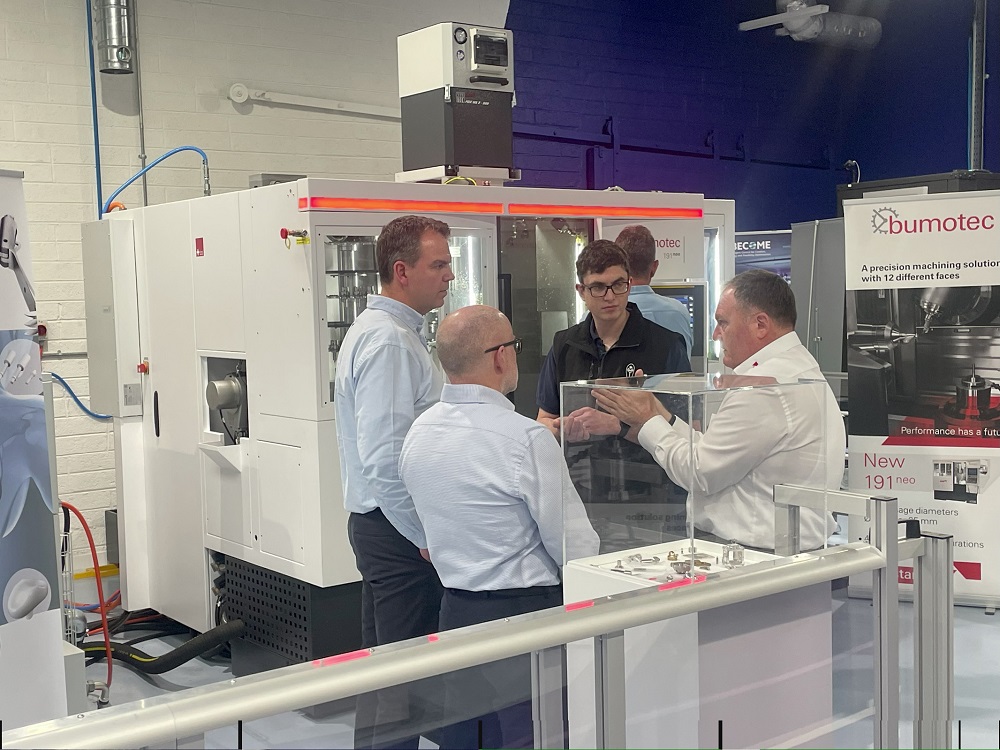The primary aim of the IMR(Irish Manufacturing Research) is to demystify, de-risk and deliver emerging technologies and new knowledge that enables industry to succeed at the cutting edge of advanced manufacturing. It is this mission statement that emphasises why the organisation has a Bumotec S191neo multi-tasking production machine at its facility in Mullingar.
Explaining the relationship between the two organisations, Chris Judge, head of machining technologies at the IMR says: “The IMR is a not-for-profit, state-funded organisation that helps Irish manufacturing companies to explore and adopt new and emerging technologies. Starrag approached us about having a Bumotec S191neo installed at our facility, and we are delighted with the machine as it enables IMR to bring very advanced technology to precision engineering companies.
He continues:“It allows engineering companies to access a high level of technology and, since its installation we’ve had multiple companies and agencies engaging with us to perform test cuts. A kind of‘test before you invest’ situation. The installation gives companies a risk-free scenario to see the potential of the technology.”
Following hugely successful pilots in ICMR and i2e2 industry-led initiatives, the IMR was established in 2014. Initial funding of €15m was approved and the first employees were hired. A collaborative R&D programme ramped up, launching projects in IoT, data analytics, chilled water optimisation, knowledge management and schedule optimisation.
To support the expansion of the research roadmap into areas such as additive manufacturing, machining and robotics, with their much larger equipment footprint, IMR successfully developed a new industrial R&D lab in the old tobacco factory in Mullingar. In partnership with a cluster of Irish SMEs, a unique national facility supporting high-TRL industry-focused research in a ‘factory’ environment was launched.
Today, IMR has more than 60 experienced employees continually developing a portfolio of highly impactful research for industry. The organisation has developed strong links with mainland Europe and won multiple EU-funded programmes. The IMR says it is delighted to be making a difference for Irish-based manufacturers and aims to assist many more on their Industry 4.0 journey.
Discussing a recent event hosted by the IMR at its facility in Mullingar, County Westmeath,Starrag UK director of sales and applications Lee Scott says: “Instead of having a seminar where lots of people come together, we a prepared a timed event where people could come and have one-to-one meetings and talk in private about problems and challenges with their parts. It enabled manufacturers to see two very different components undergo machining on the Bumotec S191neo with a changeover in between. This ability to change from one part to another, as well as the machine’s incredible capability, is a huge selling point of this technology.”
Looking closer at the machine, Starrag UK applications engineer Martin Richardson comments: “The Bumotec S191neo is an advancement from our old S191. It’s a seven-axis mill-turn machining centre, which makes it a very flexible machine with multi-axis, multi-position and multi-pick-up stations.”
He adds:“What we’re trying to do with events at the IMR is demonstrate quick changeover from one part – an anterior bone or spinal plate – to central jaws that are part of a robotic arm set-up. The robotic arm can change vice jaws, spindle collets and spindle liners from one to another in the region of 5 to 10 minutes. From there, a probing program initially sets the tooling lengths for each tool that has been changed.The machine is then back up and running in 15 to 20 minutes.”
Equipped with peripherals such as temperature-controlled high pressure, chip conveyor and bar loader makes for a modular proposition. Coupled with the Bumotec palletiser or a robotic, modular or custom-made automation cell, provides users with access to ‘24/7’ type production, which is only interrupted by preventive maintenance when required. In addition to milling and turning, the machine is also suitable for grinding, polishing, skiving, gear hobbing and diamond cutting, thereby allowing the completion of complex, demanding parts in a single cycle.
The man-machine interface, developed on a Windows-based PC application, with support for field technicians, switches from one screen to another with a simple swipe. It is therefore possible to monitor machining operations in progress, view programming parameters track production in real time. Intuitive and easy to use, Starrag reports that the Bumotec S191neo requires less training, thereby allowing its use by operators with a lower skills base.
Looking at a selection of components manufactured on the Bumotec S191neo at the IMR, Starrag UK sales manager Paul Zajac says: “The machine is capable of manufacturing a very wide range of complex parts for a various industries. Components vary from aerospace sectorparts like fuel injection systems for turbines, to implants for the medical technology industry. There’s also a wide range of parts for the watchmaking industry, the micro-mechanical sector and, in particular, very accurate parts for satellites. Components of this naturerequire machining from a wide range of materials: from plastic through to PEEK, stainless steel, carbide, ceramics [both green and white hardened ceramics that you can only grind] and titanium.”
Confirming this diversity of application range is Ethan Croke from Starrag UK: “It’s great to show the diversity of the machine and how quickly it can be changed over. Engineers need to know about the rapid changeovers and how it’s not just a machine built for a single application. The Starrag applications team are particularly strong and the machines are extremely well built.”
More information www.starrag.com















